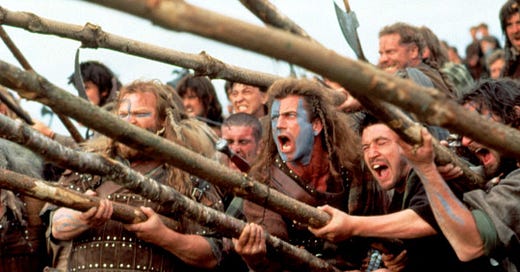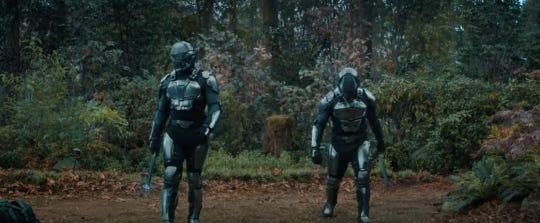Why the movie villain’s henchmen always wear masks
It's a practical choice, not an artistic one
One of those “can’t unsee it” things about modern action movies is the fact that, overwhelmingly, the generic bad guys wear face-concealing masks, particularly in mid-budget direct-to-Netflix action movies. (My definition of “mid budget” here also includes “high budget” Netflix action movies where the bulk of the budget was clearly spent hiring Ryan Reynolds.)
I dislike this for many reasons, but high among them is that it deprives the stunt actors of the opportunity to act with their faces.
For contrast, watch a Jackie Chan movie: a huge part of the fun of Jackie Chan action scenes is the incredibly human reactions that people have when delivering (or taking) punches. When the hero is punching bad guys, it’s not just about the punch itself, but the reaction of the guy who’s getting punched! When someone gets kicked in the face or takes a fist to the stomach, I want to see him react with obvious pain!
Even if the stunt actors aren’t amazingly emotive actors, it’s nice when all of the bad guys (even the “generic”) ones are visually distinctive. For one thing, it makes it easier to tell the “generic” characters straight from each other – it’s simply harder to keep track of the action when the hero is fighting five bad guys who are all basically identical. You can try to get around this by giving the bad guys face-concealing helmets that are visually distinctive, though doesn’t make a ton of sense from a lore perspective, considering the entire point of a uniform is. (Functional uniforms are, by their very nature, and by definition, designed to be uniform. It doesn’t make sense for the Galactic Empire to come up with unique helmets for each individual stormtrooper.)
But apart from the practical issues that come from all of the mooks being indistinct human-shaped blobs, there’s just the fact that as a human, I am deeply biologically hardwired to find human faces compelling. Human faces and bodies can be so delightfully idiosyncratic – no two people look the same!
And therein lies the problem for the moviemakers: if you wish to show dozens of unique human faces, then you need to have dozens of unique human faces.
If all they need to do is be excited faces in a crowd, then you can get extras. But if your movie is about a protagonist delivering bespoke acts of violence to dozens of generic bad guys, then those bad guys have to be played by stunt actors. And if you show us the stunt actors’ faces, audiences will start to notice when you start reusing stunt actors. (Even if we wouldn’t consciously register the fact that Chris Hemsworth is punching the same guy he just killed five minutes ago in a different action scene, our neural circuitry is really good at noticing familiar human faces. As Mike Stoklasa famously said, “You may not have noticed it, but your brain did.”)
So, if you only have half a dozen stunt actors, but the movie calls for dozens of bad guys getting punched or stabbed or shot, you have to cover their faces.
Realizing this has given me a greater appreciation for movies of this genre that don’t hide the actor’s faces. For example, Nobody is perfectly willing to show us the bad guy’s faces as they get punched, shot, and knocked around, which is great, because it’s a movie that is specifically about the consequences and brutality of violence.
Nobody does have one scene where the bad guys’ faces are covered – they wear ski masks during the home invasion scene, because it makes narrative sense for them to do so. But ski masks still allow them to act with their faces during the intense moments! You get to see the fear in this guy’s eyes in the moment he realizes what’s about to happen to him.
Nobody’s credits list a whopping 35 names as “stunt performers.” (And that’s not including the actors credited as “stunt double.”)
For comparison, The Adam Project has 9 credited stunt actors. No surprise, then, that all the “generic bad guys” wear helmets. (Not that they get to do much “stunt” work in the moments before they get vaporized into flashing bloodless PG-13 approved CGI dust. Not only does the movie not let you see bad guys’ faces react after they get shot, but it doesn’t even want to let you watch their bodies collapse to the ground.)
By the way, since it’s the measuring stick that all movies get measured against these days, John Wick credits 59 stunt players. (Again, this is separate and in addition to the tally of “stunt doubles,” which is a different credit.) The John Wick sequels each credit around a hundred stunt performers (John Wick 2 credits 103, John Wick 3 credits 94, John Wick 4 credits 100.)
The decision to cover everyone’s heads with face-concealing helmets can be a stylistic choice – the Star Wars franchise showcases many of these, including of course the iconic stormtrooper, among many others. However, more and more, it feels like this not a creative design choice, but a practical one.
Movies are a product of human labor and talent, and that costs money. Like a lot of the things involved in making a good movie, hiring a lot of different stunt actors isn’t easy. But I always appreciate the movies that are willing to make the effort, because when audiences see it on screen, they can tell the difference.









That's a very good point, and well made. I thought about this, and my reasoning for this "stormtrooper helmet" trope was so that the protagonists don't look like murderous psychopaths while dispatching of rows and rows of henchmen, and there is no chance of emotional connection between the viewer and the henchmen. This is also why zombies; they allow the heroes to kill dozens, hunderds of people, and we still don't register them as people, just people-shaped objects.
On a sidenote, I really enjoyed your review of Lying for Money! Good work!